
- Ethnic African American
- Artist
- Albert Fennell (4)
- Annette (4)
- Annie Lee (5)
- Byron Lars (21)
- Charles Bibbs (13)
- Dr. Lisa (5)
- Earl Jackson (3)
- Johnnie (6)
- Karen Germany (10)
- Kate Wiggs (3)
- Kelly Rogers (8)
- Martha Holcombe (7)
- Mary Blair (7)
- Mattel (6)
- Maynard Arnett (5)
- Patricia Rose (4)
- Paul Goodnight (3)
- Shady Ladies Dolls (12)
- Thomas Blackshear (4)
- Unknown (15)
- Other (1032)
- Signed
- Signed By
- Size
- Title
- Unit Of Sale
Important Vintage Old Black African American Modern Lithograph, Charles White
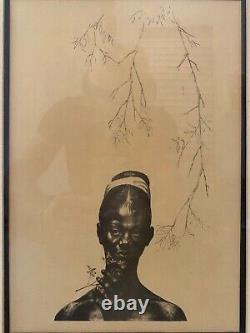
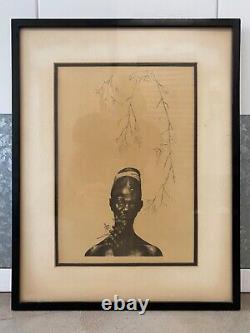
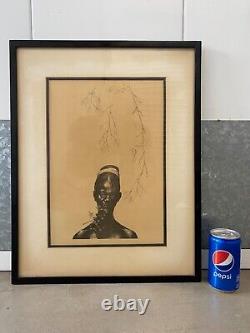



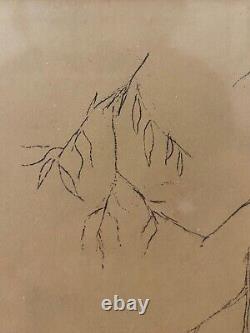
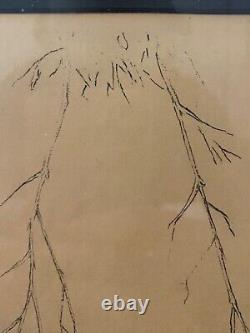

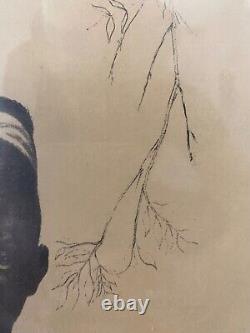

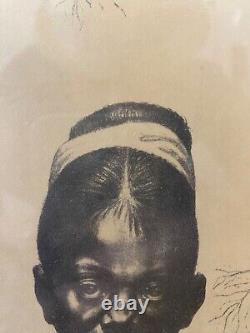
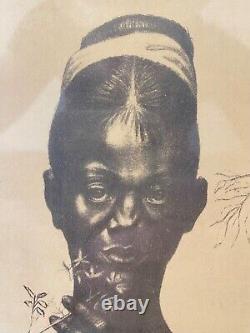
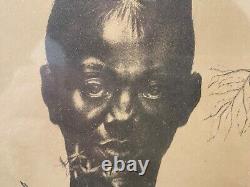







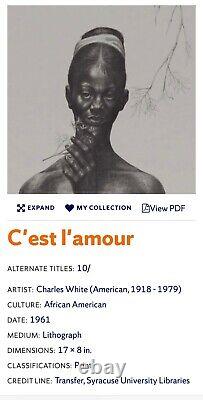
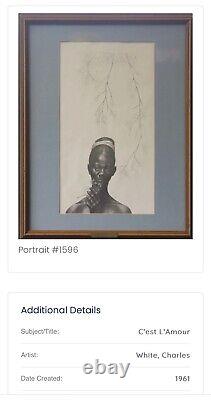
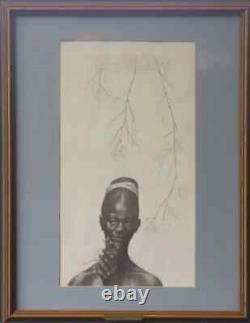


This is a RARE and Important Vintage Old Black African American Modern Lithograph on paper, by renowned 20th century African American figural artist and muralist, Charles Wilbert White 1918 - 1979. The title of this work is C'est L'Amour (1961,) which depicts an African American woman holding a flower in her left hand, with low hanging tree branches above her.
The subject stares directly at the viewer, with a hopeful and confident gaze. This lithograph was rendered from an original charcoal on paper drawing by White, created in 1961. The original drawing is owned by Lane College, in Jackson, Tennessee. This rare lithograph is not signed; however, another example of this print is in the permanent collection of Syracuse University, and their example is also not signed, so it is evident that the very limited run of this print was not signed or numbered by the artist.This print appears to be very rare, as this example and the Syracuse example are the only publicly known prints of C'est L'Amour to still exist. Approximately 14 3/4 x 18 3/4 inches including frame. Actual artwork is approximately 10 x 14 inches.
Good condition for age, with age related yellowing to the area that was exposed to the air and sunlight, and which was not covered by the matting please see photos. The frame and matting appear to be original to the piece, and likely date to the early 1960's. Acquired from an affluent old, deceased estate collection in Leimert Park, Los Angeles, California. Charles White's artworks are on display in museums across the world, and in numerous public and private collections. If you like what you see, I encourage you to make an Offer.
Please check out my other listings for more wonderful and unique artworks! 1979 - Los Angeles, California.
Black-American figure and genre and mural painting. The following, submitted June 2005, is from Charlotte Sherman, exhibition catalogue biographer of the artist. Charles Wilbert White was an artist of his people.
He always insisted upon the dignity of the individual and respect for the human being. As a spiritual product of his race and environment, he reflected the fact that his grandfather was a slave in Mississippi and his mother had lived most of her life in the South, where little had changed from her father's day.His respect for men, women and children was apparent in this search for the meaning of truth in terms of the daily life and the beauty that can be found through his drawings, paintings and prints. A warm understanding of the meaning of existence, man's aspirations and sorrows, his inner spirit, but above all his dignity, form the central core of Charles White's love affair with life.
He is quoted as saying, Paint is the only weapon that I have that which to fight what I resent. If I could write, I would write about it.If I could talk, I would talk about it. Since I paint, I must paint about it. Charles White was born in 1918 in Chicago, where the family had migrated from the South. His parents were Ethel Gary and Charles White Sr. He lived and worked in his studio in Altadena, CA.
For his last 20 years, until he died in Los Angeles in 1979. His youth was spent in Chicago.
His mother, a domestic worker, took young Charles to work with her. One day to keep him out of mischief she bought him a set of oil paints, which he then proceeded to use on the window shades. His earliest painting dates to when he was only seven years old.
His solace in a difficult life was the drawing board, and he continued to paint and draw as much as possible. He entered a nationwide high-school contest and won first prize. Later he applied for a scholarship at the Art Institute of Chicago and was granted scholarship for full-time study.
After his studies, Charles White was able to work professionally with other artists with the WPA. In 1939 under the auspices of the W. He painted the mural, "Five Great American Negroes" for the Cleveland Branch of the Chicago Public Library. This same years he exhibited at Howard University and received a commission from the Associate Negro Press to do the mural, "History of the Press" for the American Negro Exposition, Chicago. Now the artist was able to speak about the Negro heroes of American history and their contribution to American life.
Painter, Charles White would show Booker T. Washington, educator; Frederick Douglass, statesman; George Washington Carver, scientist; and Marian Anderson, singer, on the same mural. His works of art are found in museums throughout the United States, Germany, Africa and Japan. A partial list includes: Museum of Modern Art; Whitney Museum of American Art; Los Angeles County Museum of Art; Howard University Museum; Atlanta University Museum; Oakland Museum; Tuskegee Institute. American Federation of the Arts; Academy of Arts and Letters; Hirshhorn Museum, Taller de Grafica, Mexico City; Deutsche Academy der Künste, Berlin; Dresden Museum of Art. Sources: Benjamin Horowitz, "Images of Dignity, Drawings of Charles White", 1967; Sherman, Charlotte Sherman, "Charles White, Images of Dignity", exhibition catalogue, Bakersfield Museum of Art, February 26, 2004 - May 3, 2004. Biography from Phillips New York. Charles White's aspirational artworks chronicled the African American experience during the 20th century. White's work depicted American American life during the Civil Rights Struggle; he believed that art occupied a central position in the movement and worked to advance its ideals. He was particularly renowned for his use of printmaking and murals to reach a wider audience.White created what he called "images of dignity, " uplifting the African American community and making its history and struggles visible. White was born in Chicago in 1918 and attended the Art Institute of Chicago despite being rejected from several other art schools on the basis of his race.
In addition to his work as a painter, White was also a gifted teacher and a leader in his community. After moving to Los Angeles in the 1960s, he took up a position teaching at the Otis Art Institute, where David Hammons, and Kerry James Marshall were among his students. Considered one of the leading figures of post-war black figuration, his oeuvre was celebrated in a major travelling retrospective in 2018 at the Museum of Modern Art, New York; Los Angeles County Museum of Art; and The Art Institute of Chicago. Biography from Michael Rosenfeld Gallery.
Charles White was born in Chicago and studied at the School of the Art Institute of Chicago (1937-38), the Art Students League (1942), and Taller de Grafica in Mexico (1946). From 1939 to 1940, he worked as a mural painter for the Illinois Federal Arts Project. Inspired by Mexican muralists Diego Rivera and Leopold Mendez, White initially gained recognition for his social realist murals documenting milestones in black history. The recipient of numerous honors and awards, White received two Rosenwald Fellowships in 1942 and 1943, which enabled him to travel throughout the South.In 1944, he was drafted into the United States Army, but was given medical discharge when he developed tuberculosis. By this time, White was well-known for his meticulous draftsmanship and in 1947, he had his first solo exhibition at the American Contemporary Art (ACA) Gallery in New York City. From the late 1940s onward, White?
S drawings, paintings, and prints focused on African-American history and culture, and often depict ordinary men and women bearing difficult circumstances with dignity and calm. Porter observed, White was one of the great voices among black Americans who [were] among the real interpreters of the American Negro.
In 1972, White was elected a full member of the National Academy of Design, the second African-American artist to be appointed since Henry Ossawa Tanner. Towards the end of his life, White was weakened by respiratory insufficiency. However, he continued to work until his death at the age of sixty-one. In 2002, Pomegranate Press released Charles White, the first volume in The David C. Driskell Series of African-American Art.
Biography from The Johnson Collection. When interviewed about his art, Charles Wilbert White said: Paint is the only weapon that I have with which to fight what I resent. A painter, draftsman, and printmaker, White endeavored to marry his art to his beliefs. Using the plight of African Americans as his subject, White's artwork speaks to the black experience in the United States.
Born in Chicago, Illinois, Charles White's artistic gifts became evident in grade school when his teachers marked him as gifted with the paintbrush and the pencil. Although his home life was unstable and impoverished, White's single mother-a native Southerner who had migrated north- encouraged his talent, once bringing home a set of oil paints. Days spent at the Chicago Public Library (often in lieu of child care) nurtured White's love of reading and exposed him to the writers and artists of the Harlem Renaissance. His youthful proficiency at drawing earned a scholarship to Saturday classes at the Art Institute of Chicago, where his instructors included Charles Sebree and Margaret Burroughs. White's high school years were problematic, a result, in part, of his nascent struggle against racism, but his talent was undeniable.
In 1937, White received another scholarship to attend the Art Institute, one of the few schools open to black artists at that time. After completing the Art Institute's two-year program in just twelve months, White joined the ranks of artists employed by the Works Progress Administration. He worked briefly in the easel division of the Illinois branch of the Federal Art Project before transferring to the mural department, where his colleagues included former assistants of Mexican muralists Diego Rivera and José Clemente Orozco. Under WPA auspices, White executed Five Great American Negroes, the first of many important murals he would create to honor key African American leaders such as Sojourner Truth, Booker T.Washington, Frederick Douglass, Marian Anderson, and George Washington Carver. This introduction to politically engaged public art left a lasting impact on White who strove to use his creativity for social justice. In the summer of 1941, White met Elizabeth Catlett while she was studying ceramics at the Art Institute of Chicago.
They married in December of that year and moved to New Orleans where Catlett was chair of the art department at Dillard University, and White obtained an appointment to teach drawing for one semester. A year later, White won a Julius Rosenwald Foundation fellowship; as part of the award's stipulations, the couple relocated to New York, and White joined the Art Students League's faculty.That fall, White and Catlett toured the South, an experience he would later recount as one of the most deeply shaking and educative experiences of my life. After traveling for over a year, White began work on a massive mural documenting African American history, The Contribution of the Negro to American Democracy, at the Hampton Institute (now Hampton University) in Virginia. As World War II raged on, White was drafted in 1944 and served as a corporal in the all-black 132nd Engineering Regiment for eight months before being diagnosed with and then honorably discharged for tuberculosis.
During his extended convalescence, White spent the spring of 1945 as an artist-in-residence at Howard University in Washington, DC, an appointment that offered a lighter teaching load. When Elizabeth Catlett received her own Rosenwald fellowship in 1946, White followed her to Mexico. While she worked on a series centered on African American women, he was able to study directly with the muralists he had admired since his time in the WPA. The pair also became associated with the Taller de Gráfica Popular, an artists' print collective where White honed his skills in lithography. As White's health improved in the warm climate, his marriage to Catlett deteriorated, and the couple divorced in 1947. Back in New York, White continued to create a socially conscious body of work."Art, " he believed, must be an integral part of the struggle. His political affiliations during the McCarthy era attracted the attention of-and a subpoena from-the FBI. It was around this time that the dense, dynamic Social Realist style that had characterized White's earlier output gave way to works on paper executed in charcoal or muted oils, works the artists described as images of dignity.
In 1956, White sought relief for his ongoing battle with tuberculosis by moving to Southern California. There, he became an integral and influential member of a circle of creative artists, writers, and activists. Unsurprisingly, his art reflected the issues of the day and those closest to his heart, becoming more politically pointed and focused on themes of the civil rights movement. From 1965 until his death in 1979, White taught at the Otis Art Institute, fostering a new generation of socially conscious artists. White was the recipient of numerous awards and honors during his lifetime, including his 1972 election as a full member (and only the third African American member) of the National Academy of Design.
His work is held in several renowned art museums such as the Museum of Modern Art, the Art Institute of Chicago, and the Los Angeles County Museum of Art, among others. In 2018, the Art Institute of Chicago mounted the first major survey of the artist's expansive career, Charles White: A Retrospective. The Johnson Collection, Spartanburg, South Carolina.

